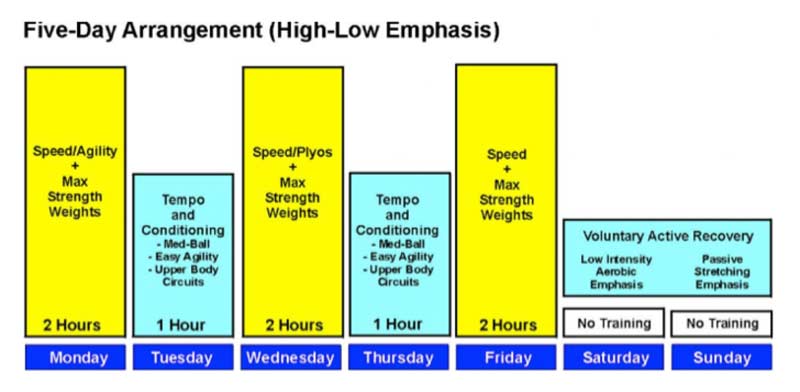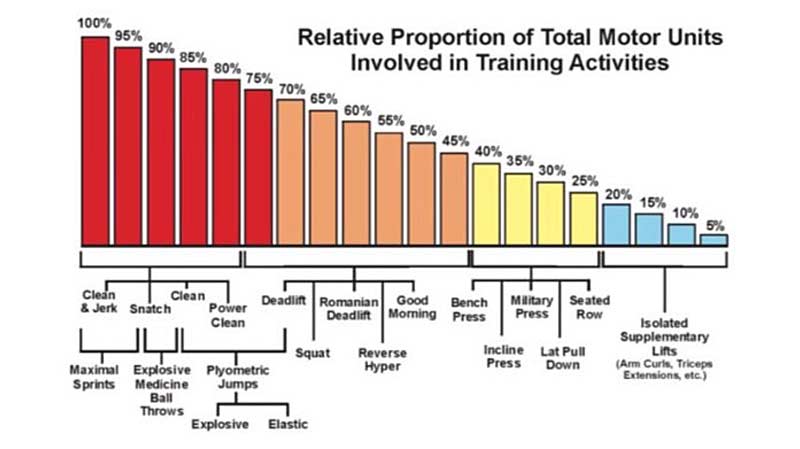Johnny Parker, Al Miller, and Rob Panariello authored a phenomenal book called The System: Soviet Periodization Adapted for the American Strength Coach, which outlines their combined 100+ years of experience in strength and conditioning. The System is based on information that came out of the former Soviet Union, which is likely some of the most relevant and accurate research done on human athletic performance.
In the book, they outline 2, 3, and 4-day program options—what they left out is a 5-day option. In this article I will describe the 5-day option, which I received indirectly from Coach Parker through a mentor of mine who is close friends with Coach Parker, and how I apply it to training 9th-12th grade boys in our athletics program.
Volume in The System
Before I outline the 5-day plan, let me recap The System’s volume principles first. The system starts with a set number of countable reps (volume total) for a 4-week training cycle. This volume total is first split into 4 weeks with a percentage based on level the of programming chosen (beginner, intermediate, or advanced). Each week’s volume of reps is then split into percentages over 2-4 days, depending on the chosen training split. The daily total volume is assigned to different lifts, depending on the emphasis of the training period, with no more than 25% of the total volume for the week assigned to one lift.
The system starts with a set number of countable reps (volume total) for a 4-week training cycle, says @LakeStrength. Share on XHere is an example of what that looks like:
The total monthly volume is 1000 reps (to make the example simple).
Total volume is distributed over 4 weeks with the following percentages
- Week 1 27% (270 Reps)
- Week 2 22% (220 Reps)
- Week 3 32% (320 Reps)
- Week 4 19% (190 Reps)
The Daily periodization follows the same percentages as the weekly volume:
Week 1 270 reps:
- Day 1 27% (72.9 Reps)
- Day 2 22% (59.4 Reps)
- Day 3 32% (86.4 Reps)
- Day 4 19% (51.3 Reps)
The reps are then assigned to lifts based on the emphasis of the training period:
- Clean 19% (51.3 reps for week 1)
- Olympic Pulls 10% (27 reps for week 1)
- Squat 20% (54 reps for week 1)
- Press 20% (54 reps for week 1)
- Posterior Chain 14% (37.8 reps for week 1)
- Jerk 7% (18.9 reps for week 1)
- Snatch 10% (27 reps for week 1)
This volume can be distributed any way the coach chooses, as long as the daily volume and reps fit with the plan.
Beyond the Book
Now that we have established the parameters that are in the book, let’s get to the information that was passed along to me from Coach Parker and how I’ve chosen to apply it.
The total monthly volume is 1000 reps (again for simplicity purposes).
Volume is distributed over 4 weeks with the following percentages:
- Week 1 27% (270 Reps)
- Week 2 22% (220 Reps)
- Week 3 32% (320 Reps)
- Week 4 19% (190 Reps)
The daily periodization follows the same percentages as the weekly volume:
Week 1 270 reps:
- Day 1 27% (72.9 Reps)
- Day 2 15% (40.5 Reps)
- Day 3 15% (40.5 Reps)
- Day 4 30% (81 Reps)
- Day 5 13% (34.1 Reps )
When giving this information to my mentor, Coach Parker mentioned that there is freedom to switch up the order any way you like as long as the percentages do not change. In the high school schedule we are currently following, we are using Charlie Francis’s high/low intensity model. Monday and Friday are the highest intensity as well as the highest volume, while Wednesday is low volume, but still high intensity; Tuesday and Thursday are the low intensity days.
Coach Parker mentioned that there is freedom to switch up the order any way you like as long as the percentages do not change, says @LakeStrength. Share on X
With this in mind, I rearranged the days to best fit the schedule for 170+ 9th-12th grade boys in soccer, baseball, football, basketball, and track:
For this schedule, I will use the same number of reps as the previous examples.
Week 1 270 reps:
- Day 1 27% (72.9 Reps)
- Day 2 13% (34.1 Reps)
- Day 3 15% (40.5 Reps)
- Day 4 15% (40.5 Reps)
- Day 5 30% (81 Reps)
I determined the daily exercises based on how the intensity of the lift fit with the intensity of the day following the Charlie Francis graph below, while also considering how many countable reps I had available that day.
I determined the daily exercises based on how the intensity of the lift fit with the intensity of the day, says @LakeStrength. Share on X
The allotment of reps for exercises we used during our first four weeks was as follows:
- Clean 16% (43.2 reps for week 1)
- Olympic Pulls 13% (35.1 reps for week 1)
- Squat 25% (67.5 reps for week 1)
- Press 22% (59.4 reps for week 1)
- Posterior Chain 15% (40.5 reps for week 1)
- Jerk 0% (0 reps for week 1)
- Snatch 9% (24.3 reps for week 1)
The layout of our weekly schedule was as follows:
Day 1—Clean Variation, Squat Variation, Press Variation
Day 2—Jerk Variation, Posterior Chain Variation
Day 3—Snatch Variation, Press Variation (non-countable squat variation)
Day 4—Olympic Pull Variation, Posterior Chain Variation
Day 5—Clean Variation, Squat Variation, Press Variation
And our running was as follows:
Day 1—Flying 10 (AM Session), Change of Direction (PM Sessions)
Day 2—Tempo Wickets
Day 3—200m Sprint 2-3 reps (Program Run/ Track Prep)
Day 4—Change of Direction
Day 5—15 yd Acceleration (AM Session), Tempo Wickets (PM Session)
I fill out the rest of my training sessions with auxiliary movements that help us achieve the goals we set at the beginning of the off-season. For example, early in off-season training, we put a higher percentage of reps towards strength movements and as the year progresses, we shift the volume towards power movements. Regularly assessing the progress of your athletes is crucial to best adjust this program for their needs.
Results from The System
The System has continued to be an excellent option for improving athlete performance and ties in very well with most programming limitations. Understanding how to program for consistent progress over a 20-week period, without overtraining, can be a difficult task without a guidepost like this. Coach Parker has a saying in regards to training: “I would rather be a mile short than take it an inch too far.”
The System has continued to be an excellent option for improving athlete performance and ties in very well with most programming limitations, says @LakeStrength. Share on XThroughout this year, we have worked hard to embody this advice. The highest monthly volume used this year was 775 reps, with the lowest being 700 reps. Any time we run flying 10’s or 15-yard accelerations, we run no more than three reps. Our longest yardage running day topped out at 700 yards. With a large number of multi-sport athletes, this plan was necessary to make sure that we were able to stimulate for improvement without fatiguing the athletes to a point where they would not be able to perform. Coincidentally, win totals are up for all spring sports as well.
The principles in this book are fundamental in nature. They provide an excellent foundation for understanding not only how to program, but why it is important. The relative intensities addressed in this book are another layer that can add to your success as a performance coach.
Since you’re here…
…we have a small favor to ask. More people are reading SimpliFaster than ever, and each week we bring you compelling content from coaches, sport scientists, and physiotherapists who are devoted to building better athletes. Please take a moment to share the articles on social media, engage the authors with questions and comments below, and link to articles when appropriate if you have a blog or participate on forums of related topics. — SF
Citations
Francis, C,. and Paul Patterson. 1992. The Charlie Francis Training System. TBLI Publications.
Parker, J., A. Miller, R. Panariello, & J. Hall. 2018. The System: Soviet Periodization Adapted for the American Strength Coach. On Target Publications.





